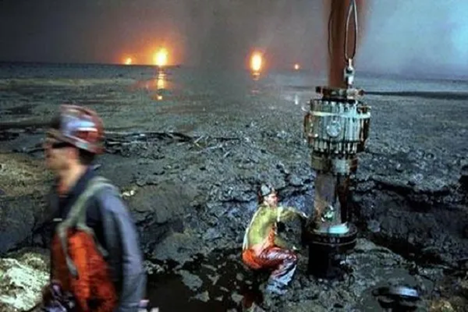Nowruz 1983: The Oil Spill That Nearly Brought the Gulf to Its Knees
Ashton Routhier
Share
In 1983, while the world’s attention was fixed on the brutal Iran–Iraq War, a quiet catastrophe was unfolding in the waters of the Persian Gulf. The Nowruz Oil Field, located just off the Iranian coast, became the epicenter of one of the most politically complicated and environmentally threatening oil spills of the 20th century.
It began with a tanker collision on February 10. The impact tilted an offshore platform 45 degrees, damaging its structure and causing an uncontainable leak. Just weeks later, Iraqi helicopters attacked the field, igniting fires that would burn for months. The platform collapse and attacks triggered a release of over 80 million gallons of crude oil into one of the most ecologically sensitive marine environments on Earth.
And yet, the most alarming part of the Nowruz disaster wasn’t what happened—but what almost did.
A Regional Crisis in the Making
By May 1983, oil slicks were drifting westward, carried by the Gulf’s circular currents. Iran, Saudi Arabia, Bahrain, Qatar, and the United Arab Emirates watched anxiously as a toxic tide edged closer to their coastlines. For these nations, the consequences of oil landfall were potentially catastrophic.
The Persian Gulf’s coastal states depend heavily on seawater desalination for drinking water. These plants, which are responsible for supplying the vast majority of fresh water in the region, are not built to filter crude oil from their intake systems. If the slick had reached shore in full force, filtration systems could have clogged within hours. Distillation chambers, once exposed to contaminated feedwater, would have been damaged or destroyed. No clean water would have meant no water at all—not just for residents, but for power plants, refineries, agriculture, and industry.
Power production was just as vulnerable. In the Gulf, energy infrastructure relies on seawater cooling. Oil entering these systems could have triggered shutdowns or equipment failure. In a worst-case scenario, cities would have faced blackouts. Hospitals and critical infrastructure could have gone dark. And with summer approaching, heat-related risks would have spiked.
Even the Gulf’s shipping arteries weren’t safe. The Saudi port of Dammam was briefly shut down as a slick passed its entrance. Larger exposure would have threatened trade routes, delayed oil exports, and stranded freight in port. At the time, that single port represented a critical hub for both economic stability and geopolitical balance.
Politics Above Prevention
Efforts to stop the spill were repeatedly stalled—not by lack of expertise, but by the war itself. Capping teams remained on standby for months, unable to reach the burning platforms. Neither Iran nor Iraq would agree to a ceasefire that might allow repairs. Instead, the leak grew. The fire burned. And the oil kept flowing.
The standoff wasn’t just military—it was ideological. Iraq used the spill as leverage, hoping the environmental damage would force international pressure on Iran. Iran, in turn, refused any solution short of Iraqi capitulation. While the two nations fought for dominance, the sea paid the price.
International offers to help—from countries including Japan, the United States, and West Germany—were largely rebuffed or stalled in bureaucratic gridlock. By the time the wells were finally capped, more than two years had passed. Twenty workers had died. The damage was done.
Fragile Waters, Lasting Impact
The Persian Gulf is one of the most vulnerable bodies of water in the world. Its shallow depth, restricted flow, and hypersaline composition make it uniquely susceptible to pollution. Oil that enters the Gulf doesn’t flush out—it lingers. It sinks. It smothers.
Although some of the spilled oil evaporated or beached on Iranian shores, a significant portion remained suspended in the water or washed onto the western coastlines. In Saudi Arabia, fishing communities reported lifeless waters where coral reefs once thrived. Kuwait’s scientific institutes noted an eerie absence of fish in normally abundant zones. Entire coastal economies were disrupted—not just by the oil itself, but by consumer fear and collapsing market demand.
Even today, the full ecological cost of the Nowruz spill remains uncertain. It’s possible it will never be known.
The Warning We Ignored
The Nowruz disaster revealed an uncomfortable truth: critical infrastructure in contested or militarized waters is at grave risk, and we remain deeply unprepared to prevent or contain such incidents when diplomacy fails.
No oil field should be left to burn unchecked for years. No nation should be forced to choose between military strategy and environmental collapse. And no region should gamble its water, power, and economy on hope that a spill "won’t reach us."
The 1983 Nowruz spill was not just a consequence of war—it was a failure of cooperation, planning, and foresight.
Final Thought
The Gulf survived Nowruz—but barely. As oil exploration and geopolitical tensions continue to overlap across the world’s seas, this disaster must be remembered not as a historical footnote, but as a pivotal warning. Infrastructure in conflict zones demands international safeguards. Oil production must be balanced with rigorous contingency planning. And above all, the global community must treat environmental protection as non-negotiable—even in war.
Because the next Nowruz might not be so forgiving.
